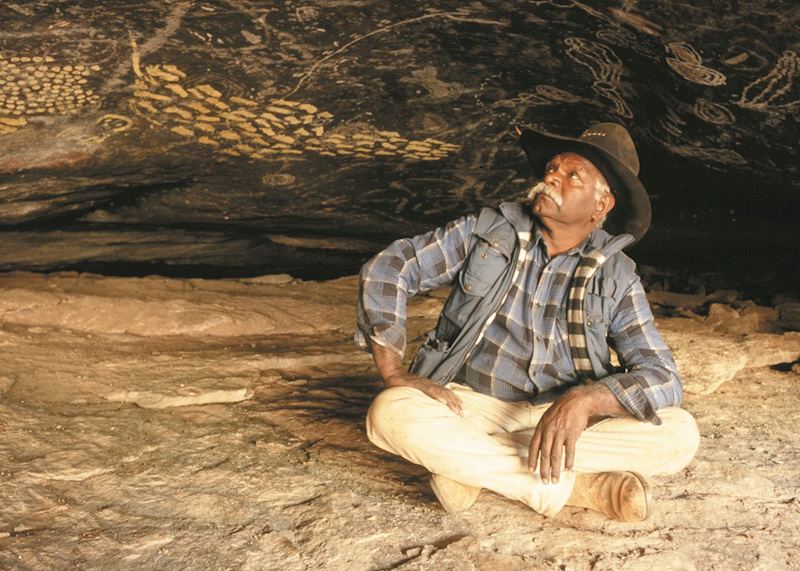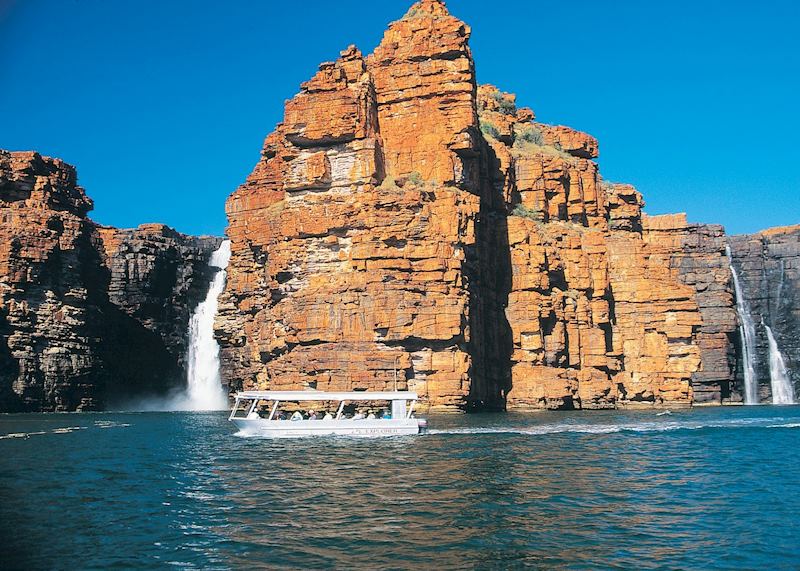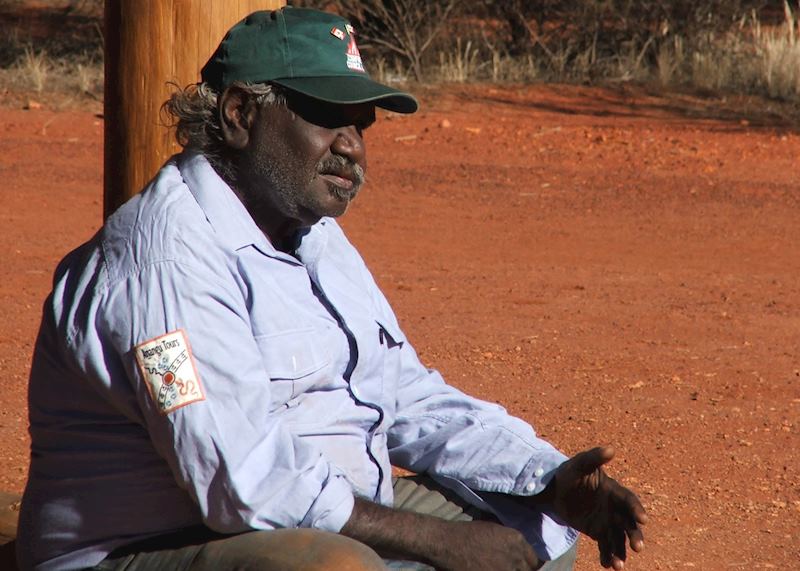By Australia specialist Ian
Looking to travel meaningfully while in Australia? A respectful and authentic Aboriginal experience will elevate your trip, opening up some of the country’s most well-known yet rarely understood sights.
Where possible, I suggest spending time with a local Aboriginal guide, who’ll talk to you vividly about the Dreaming (Aboriginal philosophy and cosmology) and show you its power and relevance to everyday life. They’ll take you to sacred places — like the remote overhang in Arnhem Land where a colossal rainbow serpent slithers across the rockface, jaw agape. Or the cave in the Margaret River region that resounds, come nightfall, with the primal tones of a didgeridoo played by Josh, a Wadandi man and accomplished musician.
Unsure where to start? Here are seven rewarding ways for connecting with Australia’s Aboriginal heritage, from guided tours to art classes and walking trails, plus suggestions for how you can weave these experiences into various routes around Australia.
1. Arnhem Land’s standout rock art
Off-grid, often waterlogged, and punctured by fearsomely angular sandstone escarpments, Arnhem Land might look uninhabitable to outsiders — but like so many areas of the Australian bush, it’s also a living, breathing sketchpad. In this case, it’s the open-air gallery and collective cultural memory of the Yolngu people, the region’s traditional landowners. The rock art here is unparalleled in its variety and clarity, with new troves being discovered all the time.
What might you see? The artworks that stick out in my mind are the images of sailing ships, which include a steamer-like vessel, a record of first contact with non-Aboriginal visitors. Some rockfaces are an ochre barrage of figures and handprints, but your guide will help you identify depictions of animals and spirit figures — including a showstopping rainbow serpent, the biggest found to date.
Get me there: A stay in the luxe safari-style lodges of Bamurru Plains nicely complements your time in Arnhem Land. Then, journey further into the Northern Territory’s Outback aboard the Ghan.

2. Uluru through Aboriginal eyes
The tip of a behemoth burnt-orange sandstone slab, tilted 90 degrees by tectonic forces and buried deep in the Earth, Uluru exerts a hypnotic pull on most visitors to Australia. But, its geology is only part of the story. The rock’s spiritual significance to the local Anangu people (known as Anangu Traditional Owners) can’t be overstated, and exploring the monolith from an Anangu perspective is, for me, one of the best ways to take it in.
Options range from al fresco dinners accompanied by an Anangu storyteller to picnicking under the stars while you watch a sound-and-light-show. In the latter, drones illuminate the sky above Uluru, lavishly narrating the story of the Mala people’s first connection to the landmark.
For a most immersive experience, I suggest taking a tour with an Anangu host to a more far-flung area of the Outback. You’ll chat over tea around a campfire, talking about everything from bushtucker to why, perhaps, a local Anangu man or woman might describe a landmark as their “grandfather” or “grandmother.” Afterwards, you’ll witness the rock glowing at sunset from a sand dune, sipping a cocktail made with bush botanicals.
Get me there: This Northern Territory trip combines time at Uluru with touring rock art sites in Kakadu National Park and includes a stop in Alice Springs — the definition of an Outback town— with its many galleries of Aboriginal art.

3. Witnessing the Kimberley’s remote rock art… by sea
Australia’s northwest Kimberley region has one of the most fractal coastlines in the world, impossible for most vessels to navigate. It’s also host to natural phenomena like the world’s only horizontal waterfalls and Montgomery Reef, which disappears and reappears with the whim of the tides.
Exploring the Kimberley by expedition cruise is an invitation to view some of the country’s most unusual and hard-to-reach rock art. You’ll have the chance to dock at Raft Point, a bluff hiding a sandstone overhang. The rock is covered with images of Wandjina, shapeshifting spirits with halo-like features fanning their heads, plus a menagerie of animal depictions, from crocodiles to dugongs. In contrast, on Jar Island you’ll examine the spindly figures typical of Gwion Gwion rock art.
Get me there: Kimberley expedition cruises can be combined with time inland at El Questro Wilderness Park, where you can soak in hot springs, fish for barramundi, and roam the outback by 4x4.

4. Perth’s headline park, with an Aboriginal guide
At first, you might struggle to detect an Aboriginal presence in Perth, with its shiny high-rises — but step into Karrgatup (King’s Park), the oasis at the heart of the city, and you can pause for breath, taking in both the greenery and the park’s importance to the Noongar people.
The best way to appreciate the park is through a walking tour with a Noongar guide. You’ll smell and touch plants used in traditional bush medicine and hear Dreaming stories as well as — my personal highlight — an ethereally beautiful song, sung in the Noongar language. The tour also takes you on the Lotterywest Federation Treetop Walkway, which gives you, in my opinion, the very best view of the city’s skyline.
Get me there: Perth is the energetic overture to a trip around lesser-known Western Australia, where you might snorkel with whale sharks on the Ningaloo Reef.

5. Walking in Aboriginal footsteps in Western Australia
Western Australia’s 125 km (78 mile) Cape to Cape Track, one of Australia’s official “Great Walks”, is a looker, no doubt. You mostly hug the coast, looking out onto the luminously turquoise Indian Ocean. Go in spring (September to November), and you’ll be distracted from the ocean views by the canvas at your feet: pink and purple splashes of wild orchids, the banana-yellow of acacias, and the bright green of scrub careering to the edge of granite cliffs. It’s also Wadandi country, land that has been trodden for thousands of years by Aboriginal people and part of a local network of bibi (paths).
We can arrange for you to complete the bulk of the walk in four days, with the bonus of gourmet picnic hampers and a stay in an exclusive retreat. You’ll take in features such as Ngilgi Cave, a karst cave system and one of several in the area that have profound significance for the Wadandi people. The route also includes coastal lookouts over renowned surf breaks, forests of towering karri trees, and beaches where you can stop to swim.
Get me there: This two-state trip pairs WA’s Great Walk with another: Tasmania’s mountainous, four-day Maria Island walk. Along with being a wildlife sanctuary and former convict site, the island is a repository of Puthikwilayti history that’s slowly being uncovered.

6. The sound of Dreaming spirits in Western Australia
There’s something about the sound of the didgeridoo that goes straight to your gut, that sounds wholly of the earth, or what the earth would sound like if it could speak. I always feel like the instrument could put you into a trance with its pulsating, primeval drone. If you’d like to hear and see the didgeridoo at its most authentic and powerful, head to Western Australia’s Margaret River region to hear Josh Whiteland. A Wadandi man and adept guide, Josh leads you first on a tour of Ngilgi Cave (see above). The cavern system is a sight in its own right, with its melting-wax-like karst formations and gravity-defying helictites. But, it’s all brought to life as Josh tells you about the Dreaming spirits who first inhabited the cave and shaped its history, as well as the cave’s continuing centrality to local Wadandi people and its connection to Country.
As night falls, Josh begins to play, using his instrument to imitate the sounds of the bush, like animal calls. He might tell you about the history of the didgeridoo and its role in ceremonies, and how — despite becoming a touristy emblem of Australian Aboriginal culture — didgeridoos are, in fact, highly specific to certain groups of people, and can only be authentically made in certain places under certain conditions.
Get me there: Josh’s tour is only one of many jewels in this expansive trip that takes you from the outback of South Australia to the winelands of the Margaret River region, via the offshore wildlife cradle that is Kangaroo Island.

7. Painting classes under the gaze of Uluru
You’ll see Aboriginal art everywhere in and around Uluru, from hotels to restaurants, as well as in the Uluṟu-Kata Tjuṯa Cultural Centre. Although eye-catching, it can be hard to understand its true complexity, beauty, and meaning, or appreciate the skill that went to its creation. If art is something that already interests you, I’d suggest taking a dot painting class during your time here.
In an “en plein air” class (under a shelter), you’ll learn how to identify the symbols of tjukurpa (creation stories) in Aboriginal art, as well as try out brushwork techniques using acrylics. As you work on your own piece, your tutor will narrate lyrical tjukurpa in Pitjantjatjara, a local Anangu language, interpreted into English by a bilingual guide.
Get me there: This 90-minute class can be easily slotted into most trips to Uluru — like this classic trip themed around Australia’s icons, which includes time in Sydney and the Great Barrier Reef.



